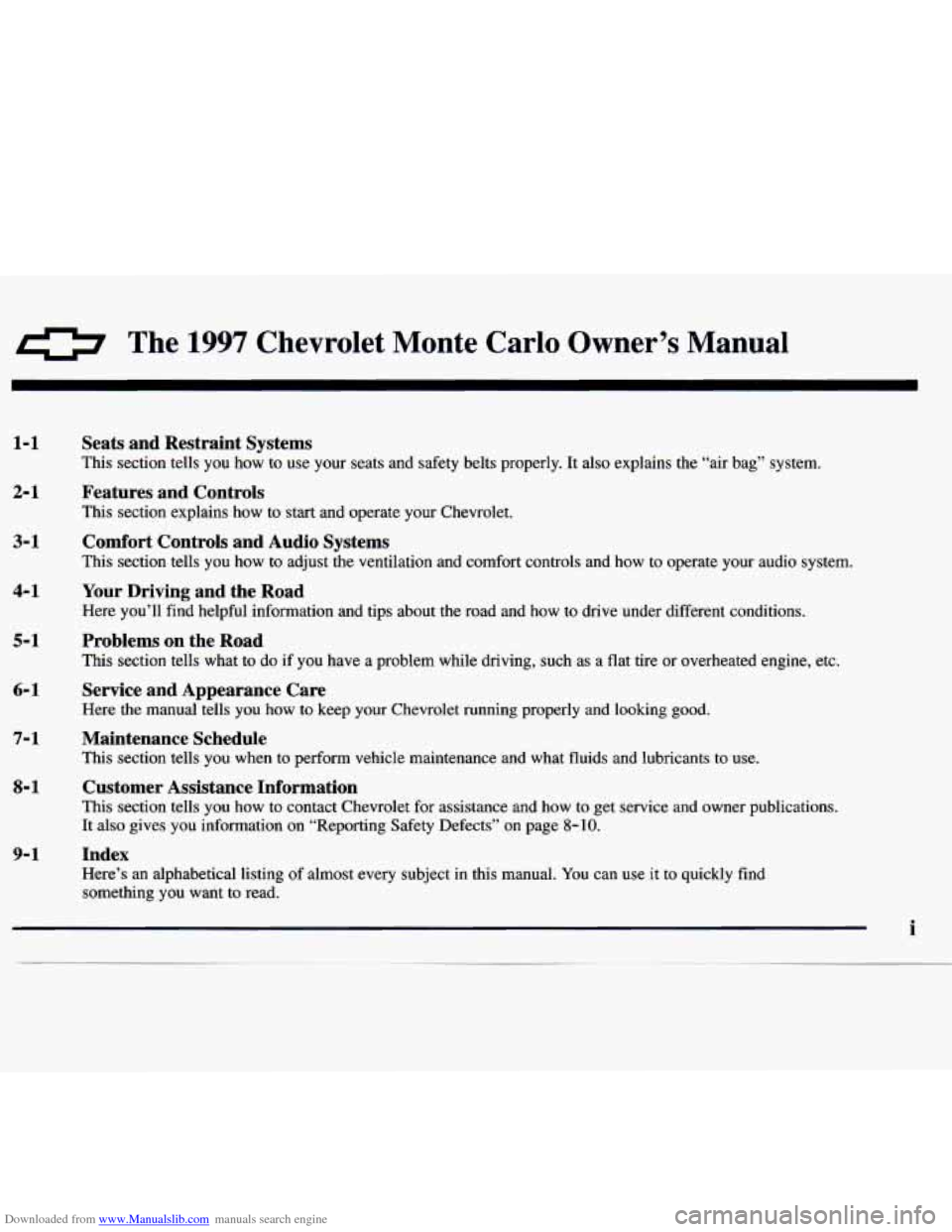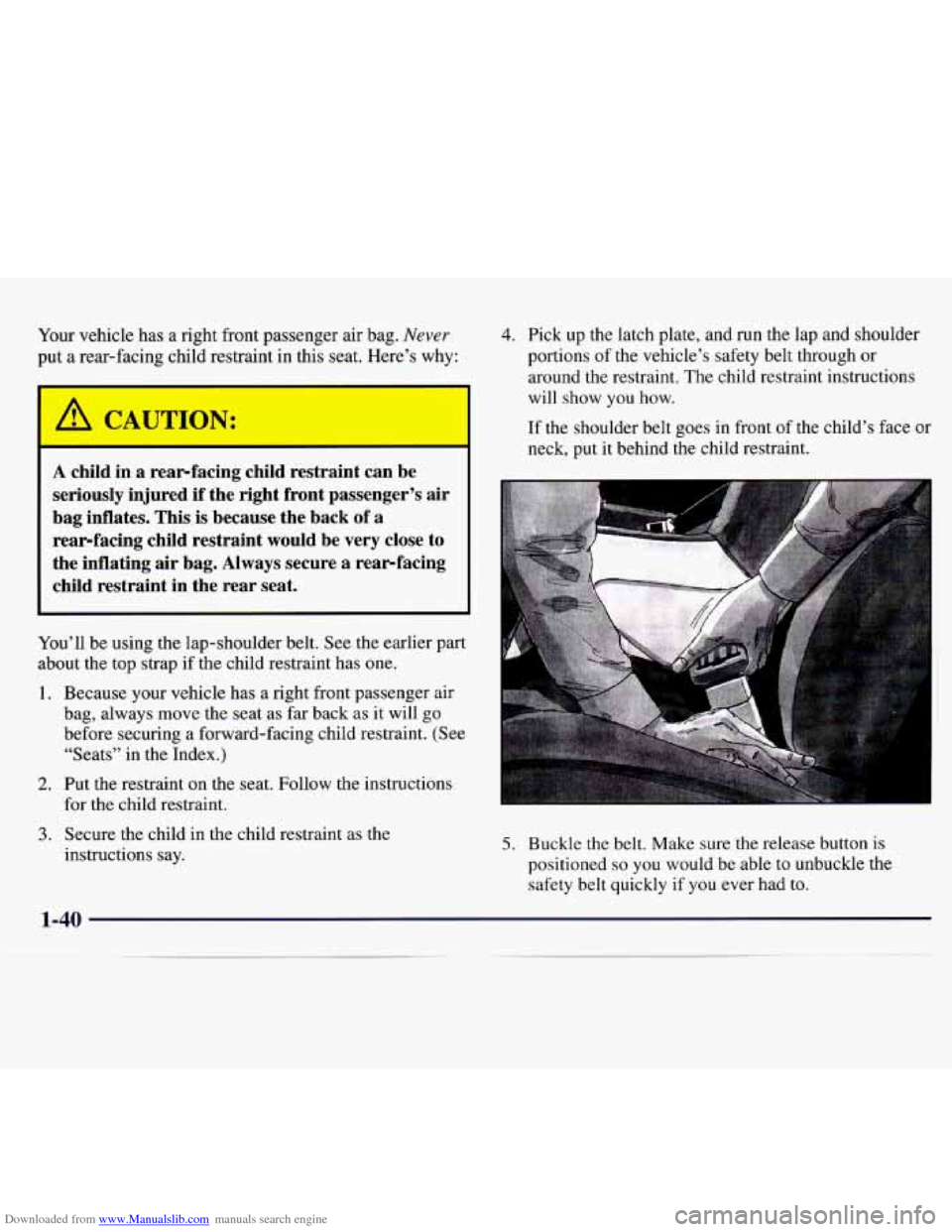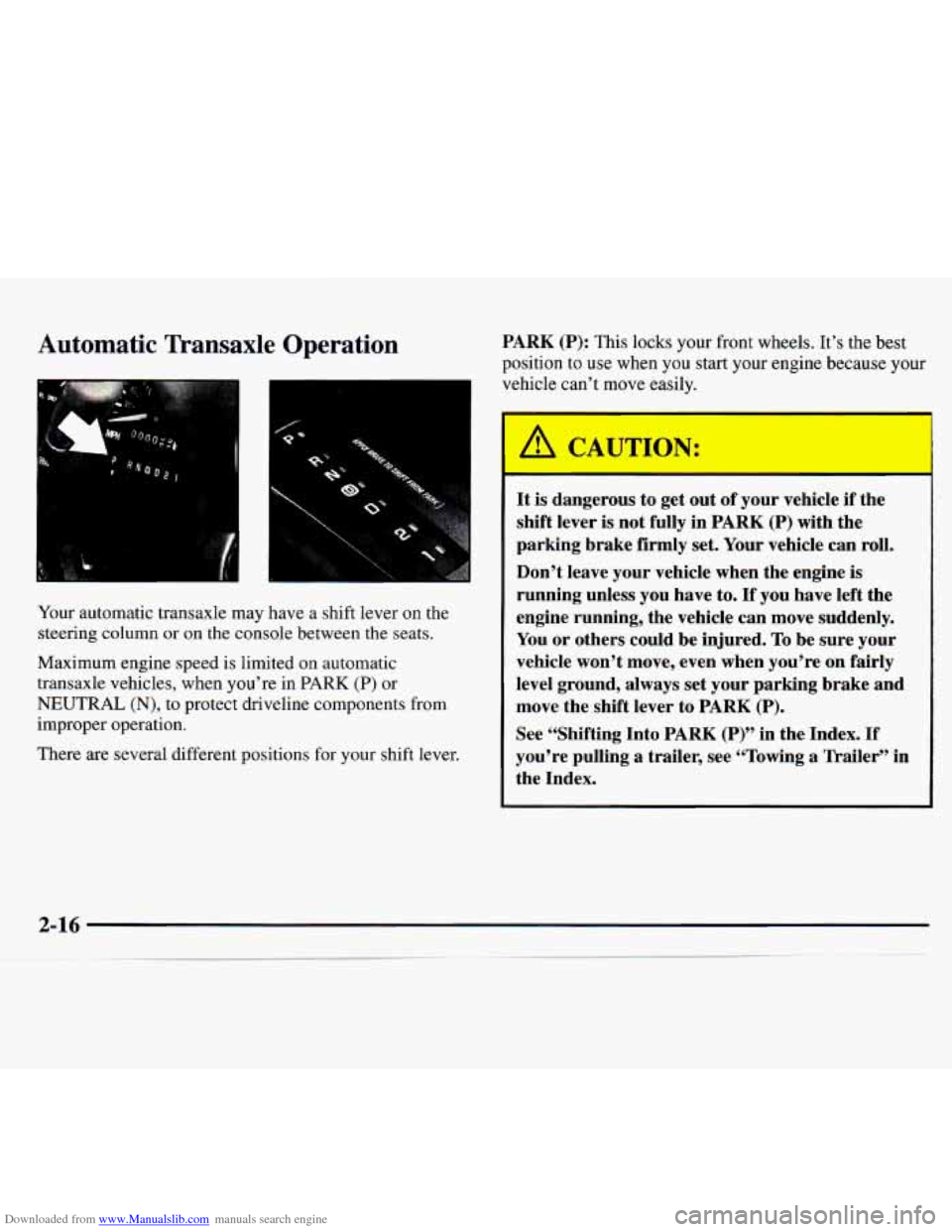Page 2 of 358

Downloaded from www.Manualslib.com manuals search engine 0 The 1997 Chevrolet Monte Carlo Owner’s Manual
1-1
2-1
3-1
4-1
5-1
6- 1
7-1
8-1
9-1 Seats and Restraint Systems
This section tells you how to use your seats and safety belts properly. It also expl\
ains the “air bag” system.
Features and Controls
This section explains how to start and operate your Chevrolet.
Comfort Controls and Audio Systems
This section tells you how to adjust the ventilation and comfort controls and how to operate your audio \
system.
Your
Driving and the Road
Here you’ll find helpful information and tips about the road\
and how to drive under different conditions.
Problems on the Road
This section tells what to do if you have a problem while driving, such as a flat tire or overheat\
ed engine, etc.
Service and Appearance Care
Here the manual tells you how to keep your Chevrolet running properly and looking good.
Maintenance Schedule
This section tells you when to perform vehicle maintenance and \
what fluids and lubricants to use.
Customer Assistance Information
This section tells you how to contact Chevrolet for assistance \
and how to get service and owner publications.
It also gives
you information on “Reporting Safety Defects” on page 8-10.
Index
Here’s an alphabetical listing of almost every subject in this manual. You can use it to quickly find
something
you want to read.
i
Page 11 of 358
Downloaded from www.Manualslib.com manuals search engine This is a correction to information found on page 6-58 and 6-59 for Lumina and Monte Carlo.
Instrument Panel Fuse Block B Not Used
Circuit
Breaker Description
C Power Windows
D Power Seats
E Not Used
Fuse Rating Description
1
5
6
Cigar Lighter-- Instrument Panel and
Console Cigar Lighters
Not Used
Not Used
HVAC
-- HVAC Control Assembly
Solenoid Box, Mix Motor, DRL Module,
HVAC Control Head, Defogger Relay,
(S.E.O.) Digital Speedometer
nazard Flasher
R.H. Spot Lamp
(S.E.O.)
A
Not Used
2
Page 14 of 358
Downloaded from www.Manualslib.com manuals search engine Section 1 Seats and Restraint Systems
Here you’ll find information about the seats in your Chevrolet and how to use your safety belts properly. You can also
learn about some things you should
not do with air bags and safety belts.
1-2
1-7
1-11
1-12
1-13 1-19
1-20
1-20
1-26
Seats and Seat Controls
Safety Belts: They’re for Everyone
Here Are Questions Many People Ask About
Safety Belts
-- and the Answers
How to Wear Safety Belts Properly
Driver Position
Safety Belt Use During Pregnancy
Right Front Passenger Position
Air Bag System Center Passenger Position
1-27
1-30
1-32
1-34
1-42
1-45
1-45
1-45
Rear Seat Passengers
Rear Safety Belt Comfort Guides for Children
and Small Adults
Children
Child Restraints
Larger Children
Safety Belt Extender
Checking
Your Restraint Systems
Replacing Restraint System Parts After
a Crash
Page 15 of 358
Downloaded from www.Manualslib.com manuals search engine Seats and Seat Controls
This section tells you how to adjust the seats and
explains reclining seatbacks, folding rear seats and
head restraints.
2-Way Manual Front Seat
I
You can lose control of the vehicle if you try to
adjust a manual driver’s seat while the vehicle
is
moving. The sudden movement could startle and
confuse you, or make you push a pedal when you
don’t want to. Adjust the driver’s seat only when
the vehicle is not moving.
Lift the bar under the front of the seat to unlock it. Slide
the seat to where you want it and release the
bar. Try to
move the seat with your body to be sure the seat is
locked into place.
Page 20 of 358

Downloaded from www.Manualslib.com manuals search engine Safety Belts: They’re for Everyone
1 This part of the manual tells you how to use safety belts
j properly. It also tells you some things you should not do
’ with safety belts. I
And it explains the air bag system.
Don’t let anyone ride where he or she can’t wear
a safety belt properly. If you are in a crash and
you’re not wearing a safety belt, your injuries
can be much worse. You can hit things inside the
vehicle or be ejected from
it. You can be seriously
injured or killed. In the same crash, you might
not be
if you are buckled up. Always fasten your
safety belt, and check that your passengers’ belts
are fastened properly too. It
is extremely
dangerous to ride in a cargo area,
inside or outside of
a vehicle. In a collision,
people riding
in these areas are more likely to be
seriously injured or killed. Do not allow people to
ride in any area of your vehicle that is not
equipped with seats and safety belts. Be sure
everyone in your vehicle is in
a seat and using a
safety belt properly.
1-7
Page 26 of 358
Downloaded from www.Manualslib.com manuals search engine Driver Position
This part describes the driver’s restraint system.
Lap-Shoulder Belt
The driver has a lap-shoulder belt. Here’s how to wear
it properly.
1. Close and lock the door.
2. Adjust the seat (to see how, see “Seats” in the Index)
so you can sit up straight.
3. Pick up the latch plate and pull the belt across you.
Don’t let
it get twisted.
The shoulder belt may lock
if you pull the belt across
you very quickly.
If this happens, let the belt go back
slightly to unlock it. Then pull the belt
across you
more slowly.
1-13
Page 53 of 358

Downloaded from www.Manualslib.com manuals search engine Your vehicle has a right front passenger air bag. Never
put a rear-facing child restraint in this seat. Here’s why:
1 A CAUTION: I
I I
A child in a rear-facing child restraint can be
seriously injured if the right front passenger’s air
bag inflates. This
is because the back of a
rear-facing child restraint would be very close to
the inflating air bag. Always secure a rearfacing
child restraint in the rear seat.
You’ll be using the lap-shoulder belt. See the earlier part
about the top strap if the child restraint has
one.
1. Because your vehicle has a right front passenger air
bag, always move the seat as far back as it will go
before securing a forward-facing child restraint. (See
“Seats”
in the Index.)
2. Put the restraint on the seat. Follow the instructions
for the child restraint.
3. Secure the child in the child restraint as the
instructions say.
4. Pick up the latch plate, and run the lap and shoulder
portions
of the vehicle’s safety belt through or
around the restraint. The child restraint instructions
will show
you how.
If the shoulder belt goes in front
of the child’s face or
neck, put it behind the child restraint.
5. Buckle the belt. Make sure the release button is
positioned
so you would be able to unbuckle the
safety belt quickly if you ever had
to.
1-40
Page 75 of 358

Downloaded from www.Manualslib.com manuals search engine Automatic Transaxle Operation
Your automatic transaxle may have a shift lever on the
steering column
or on the console between the seats.
Maximum engine speed is limited on automatic
transaxle vehicles, when you’re in
PARK (P) or
NEUTRAL (N), to protect driveline components from
improper operation.
There are several different positions for your shift lever. PARK
(P): This locks your front
wheels. It’s the best
position to
use when you start your engine because your
vehicle can’t move easily.
I
It is dangerous to get out of your vehicle if the
shift lever is not fully in PARK
(P) with the
parking brake firmly set. Your vehicle can roll.
Don’t leave your vehicle when the engine
is
running unless you have to. If you have left the
engine running, the vehicle can move suddenly.
You or others could be injured.
To be sure your
vehicle won’t move, even when you’re on fairly
level ground,
always set your parking brake and
move the shift lever to PARK
(P).
See “Shifting Into PARK (P)” in the Index. If
you’re pulling a trailer, see “Towing a Trailer” in
the Index.